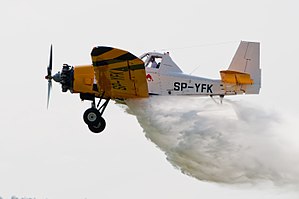| M-21 Dromader Mini | |
|---|---|

| |
| Role | Agricultural aircraft |
| National origin | Poland |
| Manufacturer | WSK-Mielec |
| Designer | Jarosław Rumszewicz[1] |
| First flight | June 18, 1982[2][3] |
| Number built | 2 |
| Developed from | PZL-Mielec M-18 Dromader[2] |
The PZL M-24 Dromader Mini (Dromader is Polish for "Dromedary"), originally named the Lama[4] (Polish for "Llama"), is a single engine agricultural aircraft, developed in the 1980s by WSK-Mielec (later PZL-Mielec) from the PZL-Mielec M-18 Dromader.[2] The prototype, registration SP-PDM, first flew on 18 June 1982.[3] It did not progress beyond the prototyping stage.[5]
Development
[edit]By the early 1980s, WSK-Mielec was aware that the economics of aerial application in agriculture varied according to the characteristics of the land being treated.[6] One relevant factor was the size of the plot, where a larger aircraft is more cost-effective for treating a larger area of land, and a smaller aircraft more cost-effective for a smaller area.[6] The company therefore decided to manufacture a range of agricultural aircraft of different sizes, based on the already-proven M-18 design.[6][7] This member of the family was intended for smaller areas of land, up to about 50 hectares (120 acres).[8]
The M-21 was designed to retain as much commonality with the M-18 as possible; ultimately around 70% was achieved.[1][9] Common areas included the cabin, rear fuselage, empennage, outer wing panels, and mainwheels.[1][9] The desire to maximise this commonality resulted in an overall weight greater than what would otherwise have been necessary.[10]
Design work commenced in January 1980 and was concluded by June that year.[1] Construction of the first prototype began in August 1981, and it first flew on 18 June 1982.[1] Three prototypes were built: two for flight testing and one for static tests.[1][9]
The prototypes were tested from 1982 to 1986, when the design was certified.[8] However, PZL did not have capacity to manufacture the design alongside the company's existing programs and no further examples were built.[8]
A turboprop version, the M-21T, powered by a Walter M601A, was designed but never constructed.[11]
Design
[edit]The M-21 is a conventional, low-wing cantilever monoplane with fixed, tailwheel undercarriage.[12] Construction is of metal throughout.[9] It is equipped with a single seat in an enclosed cabin.[9] Power is supplied by a single PZL-3SR radial engine mounted tractor-fashion in the nose.[12]
Specifications
[edit]Data from PZL M-21 Dromader Mini, p. 17
General characteristics
- Crew: 1 pilot
- Capacity: 1,700 L (450 US gal; 370 imp gal) / 965 kg (2,127 lb) of chemicals
- Length: 9.48 m (31 ft 1 in)
- Wingspan: 14.51 m (47 ft 7 in)
- Height: 3.11 m (10 ft 2 in)
- Wing area: 32.6 m2 (351 sq ft)
- Empty weight: 2,060 kg (4,542 lb)
- Max takeoff weight: 3,300 kg (7,275 lb)
- Powerplant: 1 × PZL-3SR 7-cylinder air-cooled radial piston engine, 442 kW (593 hp)
Performance
- Maximum speed: 187 km/h (116 mph, 101 kn)
- Cruise speed: 180 km/h (110 mph, 97 kn)
- Service ceiling: 2,900 m (9,500 ft)
- Rate of climb: 3.8 m/s (750 ft/min)
See also
[edit]Related development
Notes
[edit]References
[edit]- ^ a b c d e f PZL M-21 Dromader Mini, p. 17
- ^ a b c Taylor 1993, p.963
- ^ a b Simpson 1995, p.316
- ^ PZL M21 Lama, p.1
- ^ Lambert, Munson & Taylor 1991, p. 193
- ^ a b c Witkowski 1983, p.5
- ^ Glass 1983, p.6–7
- ^ a b c Luto
- ^ a b c d e Taylor 1984, p.178
- ^ PZL M21 Lama, p.16
- ^ Glass 2009, p.8
- ^ a b PZL M-21 Dromader Mini, p. 18
Bibliography
[edit]- Glass, Andrzej (May 1983). "Airplanes manufactured at PZL-Mielec". Technika lotnicze i astronautyczna. Vol. 38, no. 5. Warsaw: Stowarzyszenie Inżynierów i Techników Mechaników Polskich. pp. 6–7.
- Glass, Andrzej (2009). "Samoloty rolnicze" [Agricultural aircraft]. Polska Technika Lotnicza: Materiały historyczne. No. 1. Warsaw: Klub Miłośników Historii Polskiej Techniki Lotniczej.
- Lambert, Mark; Munson, Kenneth; Taylor, Michael J.H., eds. (1991). Jane's All the World's Aircraft 1991-92 (82nd ed.). Coulson, Surrey, UK: Jane's Information Group.
- Luto, Krzysztof. "PZL M21 "Dromader Mini", 1982 ("Lama")". Samoloty w Lotnictwie Polskim.
- "PZL-M21 Dromader Mini". Technika lotnicze i astronautyczna. Vol. 38, no. 5. Warsaw: Stowarzyszenie Inżynierów i Techników Mechaników Polskich. May 1983. pp. 17–18.
- PZL M21 Lama (Report). PZL Mielec. 1980.
- Simpson, R. W. (1995). Airlife's General Aviation. Shrewsbury: Airlife Publishing.
- Taylor, John W.R., ed. (1984). Jane's All the World's Aircraft 1984-85 (75th ed.). London: Jane's Publishing Co.
- Taylor, Michael J. H. (1993). Jane's Encyclopedia of Aviation. London: Studio Editions.
- Witkowski, Bogusław (16 January 1983). "Rodzina Dromaderow" ["Dromader family"]. Skrzydlata Polska. No. 3 (1625). Warsaw: Wydawnictwa Komunikacji i Łączności. pp. 4–5.
PZL aircraft | |||||
|---|---|---|---|---|---|
| PZL - up to 1939 (Państwowe Zakłady Lotnicze) |
| ||||
| CSS / WSK-Okęcie / PZL Warszawa-Okęcie |
| ||||
| WSK-Mielec / WSK PZL-Mielec / PZL Mielec (Polskie Zakłady Lotnicze) |
| ||||
| WSK-Świdnik / WSK PZL-Świdnik / PZL-Świdnik |
| ||||
| WSK PZL-Krosno | |||||
| Szybowcowy Zakład Doświadczalny / PZL Bielsko-Biała / Allstar PZL Glider |
| ||||